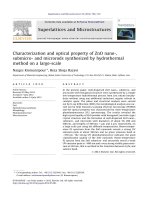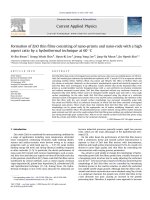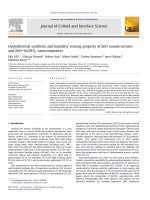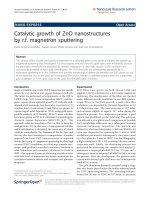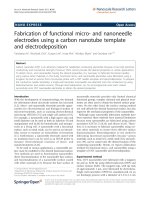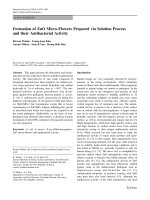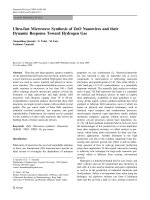Self –catalytic fabrication of ZnO micro and nano-tetrapods
Bạn đang xem bản rút gọn của tài liệu. Xem và tải ngay bản đầy đủ của tài liệu tại đây (912.43 KB, 3 trang )
<span class='text_page_counter'>(1)</span><div class='page_container' data-page=1>
VNU. JOURNAL OF SCIENCE. Mathem atics - Physics, T.xx, N03AP. 2004
<b>SELF-CATALYTIC FABRICATION OF </b>
<b>ZnO MICRO- AND NANO-TETRAPODS</b>
<b>N go X u a n D a i, N g u y en T hi T hu c H ien , N g u y e n N g o c L ong</b>
<i>D epartm ent o f Physics, College o f Science, VN U</i>
Abstract: Tetrapod-like zinc oxide (ZnO) micro and nanorods were produced on
oxidized silicon substrates by thermal evaporation of Zn/ZnO powder mixture.
The synthesis procedures were carried out at <b>1050°c </b>in air, and there is no arry
catalyst used. The fabricated ZnO tetrapods were quite uniform, high yield, good
crystallinity. and especially had very strong <b>u v </b>and green photoluminescence at
room temperature. The forming and photoluminescence mechanisms of the
tetrapods were considered.
<b>1. In tro d u c tio n</b>
<b>ZnO has been realized as an excellent functional material for many fields of </b>
<b>application. Novel superstructures of ZnO, such as nano comb-, propeller-, tetrapod-, teeth</b>
<b>like shapes [1-5], promise a great deal of interesting physical property, and can be used as </b>
<b>special building blocks, components for micro/nanosystems. Recently, in the world, many </b>
<b>attempts have been made to synthesize, characterize and apply ZnO tetrapod-like </b>
<b>structures [2-5]. Authors of [2] found that the sintering temperature of their ZnO-glass </b>
<b>varistors were evidently lowered because of the higher activity of tetrapod (TP) ZnO </b>
<b>nanopowders. Low-field electron emission and the technological usefulness of ZnO TPs </b>
<b>synthesized by rapid heating of zinc pellet was reported in [3]. Room-temperature </b>
<b>photoluminescence (PL) of ZnO TPs prepared by oxidation of zinc powders [4] or </b>
<b>evaporation of ZnC 03 powder [5] was clearly observed and it showed the potential ability </b>
<b>for fabricating light-emitting devices in nanoscale optoelectronics. For the nice application </b>
<b>prospects, the synthesis procedures, forming mechanisms and physical properties of ZnO </b>
<b>TPs are continuatively studied and developed.</b>
<b>In this paper, we report our efficient route for synthesis ZnO TPs and the beginning </b>
<b>discussion on their structural, photoluminescence properties.</b>
<b>2. E x p e rim e n ta l</b>
<b>Our synthesis method is based on a vapor </b>
<b>transport process and a simple experiment setup shown </b>
<b>in figure 1. The source material for evaporation is a </b>
<b>mixture of high purity zinc metal (Zn) and zinc oxide </b>
<b>(ZnO) powders (molar ratio 2:1). The source material </b>
<b>and the SiO^Si substrates were placed inside a quartz </b>
<b>tube, the source material was located at the closed end </b>
<b>while the substrates were arranged toward the opened </b>
<b>end of the tube. The quartz tube was inserted to a </b>
<b>horizontal furnace in air ambient. The temperature of the source material was ~1050°c, of </b>
<b>38</b>
Furnace quarzttube
<b>[■ </b>
<i>ŨŨŨD</i>
<b> a*</b>
source material substrates
</div>
<span class='text_page_counter'>(2)</span><div class='page_container' data-page=2>
<i>Self-catalytic fabrication of...</i>
3 9<b>the substrates was in range 850-:-950°C. The temperature was kept for 1.5 hour, and then </b>
<b>naturally cooled down to room temperature. After the experiment, white fluffy products of </b>
<b>mass yield were found on the substrates and the quartz tube. The products covered on the </b>
<b>substrates were collected for characterization. Morphology and crystal structure of the </b>
<b>products were characterized bv scanning electron microscopy (SEM) (JEOL JSM 5410 LV) </b>
<b>and X-ray diffractometer (Brucker D5005). Photoluminescence of the samples were </b>
<b>recorded by a spectrofluorometer (FL3-22 Jobin-Yvon).</b>
<b>3 . R e su lts a n d d is c u s s io n</b>
<b>X-ray </b> <b>diffraction </b> <b>(XRD) </b> <b>patterns </b> <b>of the </b>
<b>synthesized products show characteristic diffraction </b>
<b>peaks of hexagonal wurzite ZnO crystal phase, there </b>
<b>is no any diffraction signal of impurity (fig.2).</b>
The typical SEM image shown in fig.3
<b>illustrates the tptrapod-like shape of the synthesized </b>
<b>ZnO products. Each tetrapod is composed of four ZnO </b>
<b>micro/nanorods - legs of tetrapods - with the diameter </b>
<b>o f about 500-7-2000 nm and length of several </b>
<b>micrometers, this sizes depend on the location of the </b>
<b>substrate in the quartz tube of the synthesis process.</b>
<b>All the legs o f the TPs have smooth surface and </b>
<b>particularly have hexagon end planes, as can be </b>
<b>seen in the SEM image (fig. 3).</b>
<b>Hexagonal wurzite cell of ZnO presents a </b>
<i><b>polar oxide (or zinc) {001] plane and an electrically- </b></i>
<i><b>neutral non-polar [100] plane, as shown in the inset </b></i>
<b>picture of figure 2. The polar plane is metastable </b>
<b>and thus favors a fast growth rate, while the non</b>
<b>polar face has higher stability Ị6Ị. We believe that in </b>
<b>our synthesis conditions ZnO nuclei formed in the </b>
<b>typical hexagonal wurzite structure and fast grew </b>
<b>up </b> <b>layer-by-layer </b> <b>along </b> <b>the </b> <b>c-axis (<0001>), </b>
<b>therefore resulted in hexagonal shape, end planes </b>
<b>and single crystalline of the legs of the ZnO TPs.</b>
<b>Both vapor-liquid-solid (VLS) and vapor-solid </b>
<b>synthesis procedures because at the synthesis temperature (850-950"C), ZnO solids, ZnOx </b>
<b>(x<l), Zn liquids could exist together and play as the self-catalysts for the growth of ZnO </b>
<b>micro/nanorods (the legs of TPs) [1, 5], However, the v s mechanism may dominate due to </b>
<b>that Zn and ZnO, liquid droplets (with boiling point of 907°C) easily transit to gaseous state </b>
<b>at the synthesis temperature. The explanation for the forming of the tetrapod-like </b>
<b>morphology is still an exciting problem for worldwide research. May be, the volcanic </b>
<b>oxidation of Zn powder plays an important role leading to the growth of the ZnO TPs. Four </b>
<b>legs of each TP may form and lengthen from one starting ZnO nucleus.</b>
<b>2 theta degree </b>
<b>Fig.2. XRD pattern of ZnO tetrapod </b>
<b>products ; The inset is the hexagonal </b>
<b>unit cell of ZnO [6]</b>
</div>
<span class='text_page_counter'>(3)</span><div class='page_container' data-page=3>
4 0
<i>Ngo Xuan Dai, Nguyen Thi Thuc Hien, Nguyen Ngoc Long</i>
<b>Room-temperature photoluminescence spectra of </b>
<b>the ZnO TPs excited with a 335 nm light (from a 450W </b>
<b>Xenon lamp) were shown in Fig. 4. Very inten se </b>
<b>emission peaks at 388 nm (UV) and 495 nm (green) </b>
<b>were observed in all the synthesized samples. The first </b>
<b>narrow peak at 388 nm can be attributed to excitonic </b>
<b>recombination. This u v peak is red shift in comparison </b>
<b>with the 380 nm peak of usual cases of ZnO. The broad </b>
<b>peak at 495 nm is mainly due to oxygen vacancies </b>
<b>(inducing deep levels) in the ZnO crystals [7]. The ZnO </b>
<b>materials of our case formed in the zinc-rich (oxygen- </b>
<b>deficient) condition, especially for the positions near the </b>
<b>source material and far from the opened end (air </b>
<b>ambient) of the synthesis quartz tube (fig. 1). The </b>
<b>further distance from the opened end of the tube, the </b>
<b>higher probability of forming oxygen vacancies, thus the </b>
<b>green emission increases and the ƯV emission is </b>
<b>partially quenched (fig. 4). The representative excitation </b>
<b>spectrum of the 495 nm emission peak (fig.5) indicates </b>
<b>the optical semiconductor nature of the ZnO TPs with </b>
the clea r excito nic absoi'ption peak a t 381 nm. G ood
<b>excitonic optical transitions can reveal the high purity </b>
<b>and good crystallinity of the ZnO products.</b>
<b>4. S um m ary</b>
<b>We have fabricated tetrapod-like ZnO micro/nanorods by a sim ple experiment setup. </b>
<b>The synthesis process, forming mechanism and physical properties of the ZnO tetrapods are </b>
<b>still the land for active researches in coming time. Very high intense ultra-violet and green </b>
<b>photoluminescence at room temperature of our synthesized ZnO tetrapods exposes the </b>
<b>potential for fabricating micro and nanoscale light-em itting devices.</b>
<b>R eferen ces:</b>
<b>1. Peidong Yang, Haoquan Yan, s . Mao, R. Russo, J. Johnson, R. Saykally, N. Morris. J. </b>
<i><b>Pham, R. He, H. Choi, Adv. Fund. Mater.. 12, No.5(2002), 323.</b></i>
<i><b>2. Wu Jun, Xie Changsheng. Bai Zikui, Zhu Bailin, Huang Kaijin, Wu Run, Mater. Sci. Eng. </b></i>
<b>B95(2002) 157.</b>
3. Q. Wan. K. Yu , T.H . Wang, C .L. L in , <i>Appl. Phys. Lett.,</i> 83(2003), 2253.
<i><b>4. Y.Dai, Y. Zhang, Q.K. Li, c . w . Nan, Chem. Phys. Lett, 358(2002). 83.</b></i>
<i><b>5. w . D.Yu, X. M. Li, X. D. Gao, Appl. Phys. Lett, 84(2004). 2658.</b></i>
<i><b>6. L. Znaidi. G.J.A.A Illia. s . Benyaha, c . Sanchez, A.v. Kanaev, T hin Solid Films, 428(2003).</b></i>
257.
<i><b>7. K. Vanheusden, W.L. Warren, C.H. Seager, D.R. Tallant, J. A. Voigt, J. Appl. Phys, 79(10), </b></i>
<b>(1996), 7983.</b>
381 nm
wavelength nm
Fig.5. Excitation spectrum of
the synthesized ZnO TPs.
wavelength nm
Fig.4. P L spectra o f the ZnO TP s
formed near (solid line) and far
from (dotted line) the opened end
</div>
<!--links-->

